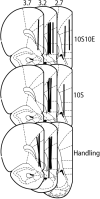Medial Prefrontal Cortical Dopamine Responses During Operant Self-Administration of Sweetened Ethanol
- PMID: 27435872
- PMCID: PMC5573256
- DOI: 10.1111/acer.13141
Medial Prefrontal Cortical Dopamine Responses During Operant Self-Administration of Sweetened Ethanol
Abstract
Background: Medial prefrontal cortex (mPFC) dysfunction is present in heavy alcohol consumers. Dopamine signaling in mPFC is associated with executive functioning and affects drinking behavior; however, direct measurement of extracellular mPFC dopamine during appetitive and consummatory ethanol (EtOH) self-administration behavior has not been reported.
Methods: We used in vivo microdialysis in freely behaving, adult, male, Long Evans rats to determine extracellular dopamine concentration in the mPFC during operant self-administration of an EtOH-plus-sucrose or sucrose solution. The model separated appetitive/seeking from consummatory phases of the operant session. Dopamine was also monitored in an untrained handling control group, and dialysate EtOH was measured in the EtOH-drinking group.
Results: Home cage baseline dopamine was lower in rats that experienced a week of drinking sweetened EtOH compared with sucrose-drinking and handling controls. Transfer into the operant chamber and the initiation of consumption stimulated a relatively higher change in dopamine over baseline in the sweetened EtOH group compared with sucrose and handling controls. However, all groups show a dopamine response during transfer into the operant chamber, and the sucrose group had a relatively higher change in dopamine over baseline during initiation of consumption compared with handling controls. The time courses of dopamine and EtOH in the mPFC differ in the EtOH-consuming rats.
Conclusions: Differences in extracellular mPFC dopamine between EtOH drinkers compared with control groups suggest that mPFC dopamine is involved in the mechanism of operant self-administration of sweetened EtOH and sucrose. Furthermore, the increase in dopamine during consumption is consistent with a role of mPFC dopamine in reward prediction.
Keywords: Appetitive; Consumption; Ethanol; Ethanol-Seeking; Mesocortical; Operant Self-Administration.
Copyright © 2016 by the Research Society on Alcoholism.
Conflict of interest statement
Conflict of interest: The authors have no conflict of interests.
Figures






Similar articles
-
Intravenous Ethanol Administration and Operant Self-Administration Alter Extracellular Norepinephrine Concentration in the Mesocorticolimbic Systems of Male Long Evans Rats.Alcohol Clin Exp Res. 2020 Aug;44(8):1529-1539. doi: 10.1111/acer.14397. Epub 2020 Jul 20. Alcohol Clin Exp Res. 2020. PMID: 32573991 Free PMC article.
-
Operant self-administration of sweetened ethanol and time course of blood ethanol levels in adolescent and adult male Long-Evans rats.Alcohol Clin Exp Res. 2015 Mar;39(3):485-95. doi: 10.1111/acer.12630. Epub 2015 Feb 19. Alcohol Clin Exp Res. 2015. PMID: 25702920 Free PMC article.
-
Lack of effect of nucleus accumbens dopamine D1 receptor blockade on consumption during the first two days of operant self-administration of sweetened ethanol in adult Long-Evans rats.Alcohol. 2015 Sep;49(6):543-51. doi: 10.1016/j.alcohol.2015.05.003. Epub 2015 May 30. Alcohol. 2015. PMID: 26142563 Free PMC article.
-
Understanding ethanol's acute effects on medial prefrontal cortex neural activity using state-space approaches.Neuropharmacology. 2021 Oct 15;198:108780. doi: 10.1016/j.neuropharm.2021.108780. Epub 2021 Sep 1. Neuropharmacology. 2021. PMID: 34480911 Free PMC article. Review.
-
Operant ethanol self-administration in ethanol dependent mice.Alcohol. 2014 May;48(3):295-9. doi: 10.1016/j.alcohol.2014.02.002. Epub 2014 Mar 13. Alcohol. 2014. PMID: 24721194 Free PMC article. Review.
Cited by
-
Intravenous Ethanol Administration and Operant Self-Administration Alter Extracellular Norepinephrine Concentration in the Mesocorticolimbic Systems of Male Long Evans Rats.Alcohol Clin Exp Res. 2020 Aug;44(8):1529-1539. doi: 10.1111/acer.14397. Epub 2020 Jul 20. Alcohol Clin Exp Res. 2020. PMID: 32573991 Free PMC article.
-
The reinforcing effects of ethanol within the prelimbic cortex and ethanol drinking: Involvement of local dopamine D2 receptor-mediated neurotransmission.Drug Alcohol Depend. 2020 Sep 1;214:108165. doi: 10.1016/j.drugalcdep.2020.108165. Epub 2020 Jul 2. Drug Alcohol Depend. 2020. PMID: 32688071 Free PMC article.
-
Functional role for cortical-striatal circuitry in modulating alcohol self-administration.Neuropharmacology. 2018 Mar 1;130:42-53. doi: 10.1016/j.neuropharm.2017.11.035. Epub 2017 Nov 26. Neuropharmacology. 2018. PMID: 29183687 Free PMC article.
-
New Treatment Perspectives in Adolescents With Anorexia Nervosa: The Efficacy of Non-invasive Brain-Directed Treatment.Front Behav Neurosci. 2018 Jul 20;12:133. doi: 10.3389/fnbeh.2018.00133. eCollection 2018. Front Behav Neurosci. 2018. PMID: 30083095 Free PMC article.
-
Neurobiological Bases of Alcohol Consumption After Social Stress.Curr Top Behav Neurosci. 2022;54:245-281. doi: 10.1007/7854_2021_273. Curr Top Behav Neurosci. 2022. PMID: 34964935 Free PMC article.
References
-
- Bassareo V, Tanda G, Petromilli P, Giua C, Di Chiara G. Non-psychostimulant drugs of abuse and anxiogenic drugs activate with differential selectivity dopamine transmission in the nucleus accumbens and in the medial prefrontal cortex of the rat. Psychopharmacology. 1996;124:293–299. - PubMed
-
- Bechara A, Damasio H. Decision-making and addiction (part I): impaired activation of somatic states in substance dependent individuals when pondering decisions with negative future consequences. Neuropsychologia. 2002;40:1675–1689. - PubMed
-
- Bechara A, Van Der Linden M. Decision-making and impulse control after frontal lobe injuries. Curr Opin Neurol. 2005;18:734–739. - PubMed
Publication types
MeSH terms
Substances
Grants and funding
LinkOut - more resources
Full Text Sources
Other Literature Sources

